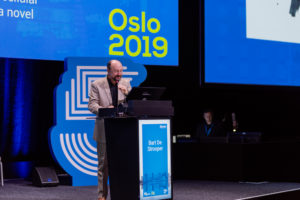Presidential Symposium Report
By Tom Jenkins and Tim Von Oertzen
The Brain Prize Lecture: The prodromal cellular phase of Alzheimer’s disease (AD): toward a novel understanding of the disorder
Charles Edouard Brown-Séquard Lecture: Do we need to reinvent translational cerebrovascular research?
The Moritz Romberg Lecture: Translational neuroscience to improve outcomes for MND: are we winning?
 The Brain Prize Lecture was given by Prof Bart De Strooper, a world-leading expert on the pathogenesis of Alzheimer’s disease, who works both at the University of Leuven, Belgium and University College London, UK. His lecture was titled: “The prodromal cellular phase of Alzheimer’s disease (AD): toward a novel understanding of the disorder”. He started by pointing out the need for investment into this huge healthcare challenge, offering parallels with cancer research, then took us through familial AD. He described the three known genetic causes of AD: amyloid precursor protein and presenilin 1 and 2, and the role of secretases which cleave amyloid-beta. Destabilisation of presenilin causes release of longer amyloid-beta peptides, which are associated with younger onset AD. So, amyloid-beta and secretase cleavage appear central at a molecular mechanistic level, but unfortunately therapeutic trials- 234 to date- targeting these pathways have so far been unsuccessful. An example was the trial of semagacestat, which targets gamma secretase pathways, but Prof De Strooper pointed out that there may have been pharmacokinetic reasons for this: the compound has a very short half-life and, although beta amyloid levels were demonstrated to decrease in blood, no effect on cerebrospinal fluid levels was evident. Therefore, the dose may have been sub-therapeutic, by trying to minimise side effects. Further trials targeting this pathway and addressing methodological issues may be indicated.
The Brain Prize Lecture was given by Prof Bart De Strooper, a world-leading expert on the pathogenesis of Alzheimer’s disease, who works both at the University of Leuven, Belgium and University College London, UK. His lecture was titled: “The prodromal cellular phase of Alzheimer’s disease (AD): toward a novel understanding of the disorder”. He started by pointing out the need for investment into this huge healthcare challenge, offering parallels with cancer research, then took us through familial AD. He described the three known genetic causes of AD: amyloid precursor protein and presenilin 1 and 2, and the role of secretases which cleave amyloid-beta. Destabilisation of presenilin causes release of longer amyloid-beta peptides, which are associated with younger onset AD. So, amyloid-beta and secretase cleavage appear central at a molecular mechanistic level, but unfortunately therapeutic trials- 234 to date- targeting these pathways have so far been unsuccessful. An example was the trial of semagacestat, which targets gamma secretase pathways, but Prof De Strooper pointed out that there may have been pharmacokinetic reasons for this: the compound has a very short half-life and, although beta amyloid levels were demonstrated to decrease in blood, no effect on cerebrospinal fluid levels was evident. Therefore, the dose may have been sub-therapeutic, by trying to minimise side effects. Further trials targeting this pathway and addressing methodological issues may be indicated.
The second reason for failure of clinical trials may be the time factor. Amyloid, and then tau, increase up to 30 years before brain structural changes and clinical features develop, so we may be treating too late; by analogy with cancer, perhaps we are treating during the metastatic phase.
Twins studies have shown that two thirds of the risk for sporadic disease is genetic. Genome-wide association studies have identified around 1000 risk genes, and polygenic risk scores can be calculated. Interestingly, there is good evidence that genetic risk is related to microglial responses to amyloid plaques (but not tangles). Transcriptomic work has demonstrated upregulation of microglial, astroglial and complement genes in response to amyloid, in linked patterns suggesting a regulatory network. This raises the possibility that amyloid plaques are the trigger but not the driver for AD. The driver may instead be the microglial response, which is dependent on polygenic risk. Neurodegeneration appears a downstream event from inflammation. Prof De Strooper advocated being more proactive to detect AD earlier in the future. A tailored approach is likely to be required, through a combination of individual genetic profiling, home cognitive tests, and early combination therapeutics which will probably need to address both triggers and drivers: anti-amyloid, anti-inflammatory and novel genetic approaches.
Prof. Ulrich Dirnagl started his lecture by interpreting the title slightly different: Increasing value and reducing waste in translational neuroscience.
At the beginning of the era of translational cerebrovascular research, it was the general opinion, that any change in stroke is down to lack of perfusion only. Since the 1990’s publications in the field of basic science in cerebrovascular translational research (CVTR) have started to increase and have continued to increase steadily to over 3000 per year. Even in the most recent time, several publication in Nature featured CVTR indicating involvement of capillary pericytes in regulating cerebral blood flow, transfer of mitochondria post stroke from astrocytes to neurons, and suppression of astrogliosis and potential recovery by brain regulating T-cells. All of this in mice, in models of cerebrovascular disease. He mentioned the frequently discussed article titled ‘Restoration of brain circulation and cellular function hours after post-mortem’ and added … in pigs. In summary, during the last decades CVTR identified the complex pathobiology of tissue damages in stroke involving not only neurons but astrocytes, oligodendrocytes, microglia, basal membrane, extracellular space, pericytes, endothelium, and last not least immune cells. The time course of the changes after the stroke onset identifies mechanisms of damage as well as endogenous brain protection as well as plasticity, regeneration and repair. Finally a pooled analysis of neuroprotection trials identified that all interventions reported showed a protective effect in the animal models.
Referring to movie title, the ‘trouble in paradise’ is that those results have been shown in rats and mice mostly, and similar trials for neuroprotection in humans failed to show positive or significant effect.
Prof Dirnagl did scrutinize the success of CVTR. Have been decades of hard work and investment of funding been wasted? Can you compare mice to man?
Indeed there is good data that time windows in acute stroke are comparable between mice and man. Although the developments of treatment progress in stroke came from clinical research, this might have been the low hanging fruits. In contrast, in (CV)TR many studies have had only 8 animals investigated. Clinical trial designs for neuroprotection had a mean inclusion time window of 16 hours, which well beyond the clinical applied time windows. Changing the concept of studying animal models in larger numbers, in blinded study designs, developing more appropriate study designs and other changes will reduce bias and increase quality of results. Increasing internal validity, sample sizes, external validity, and report of neutral and negative results should define the new standard. Open data policies, collaboration in multicenter trials and preregistration of study protocols will support this development. All those measure will open the chance to develop new treatments based on results of translational neuroscience research.
 The Moritz Romberg lecture was delivered by Professor Dame Pamela Shaw from the University of Sheffield, UK, an international expert in motor neuron disease (MND) research and clinical care. Her lecture was entitled “Translational neuroscience to improve outcomes for MND: are we winning?” She started by acknowledging several giants of European neurology from the past, and moved on to describe the anatomy of the motor neuron, and the burden of its dysfunction in motor neuron disease (MND). MND is a clinically, genetically, pathologically and prognostically heterogeneous condition. Advances in genetics and their contribution to understanding pathophysiological mechanisms were highlighted, including the most prevalent gene, C9ORF72, the basis of mouse models, SOD1, and a more recent discovery from Prof Shaw’s group, GLT8D1, which implicates ganglioside dysfunction. In terms of pathology, MND is a TDP-43 proteinopathy in most cases, characterised by protein mislocalisation from the nucleus to the cytoplasm. Importantly, SOD1 MND, unlike most other forms of MND lacks TDP-43 pathology. In C9ORF72 disease, there is TDP-43 proteinopathy but also additional dipeptide repeats, which are thought to contribute to toxicity. In addition to proteinopathy, at least 11 inter-connected molecular pathways and mechanisms have been implicated in pathophysiology, and this complexity has contributed towards difficulties in developing disease-modifying therapies.
The Moritz Romberg lecture was delivered by Professor Dame Pamela Shaw from the University of Sheffield, UK, an international expert in motor neuron disease (MND) research and clinical care. Her lecture was entitled “Translational neuroscience to improve outcomes for MND: are we winning?” She started by acknowledging several giants of European neurology from the past, and moved on to describe the anatomy of the motor neuron, and the burden of its dysfunction in motor neuron disease (MND). MND is a clinically, genetically, pathologically and prognostically heterogeneous condition. Advances in genetics and their contribution to understanding pathophysiological mechanisms were highlighted, including the most prevalent gene, C9ORF72, the basis of mouse models, SOD1, and a more recent discovery from Prof Shaw’s group, GLT8D1, which implicates ganglioside dysfunction. In terms of pathology, MND is a TDP-43 proteinopathy in most cases, characterised by protein mislocalisation from the nucleus to the cytoplasm. Importantly, SOD1 MND, unlike most other forms of MND lacks TDP-43 pathology. In C9ORF72 disease, there is TDP-43 proteinopathy but also additional dipeptide repeats, which are thought to contribute to toxicity. In addition to proteinopathy, at least 11 inter-connected molecular pathways and mechanisms have been implicated in pathophysiology, and this complexity has contributed towards difficulties in developing disease-modifying therapies.
Meanwhile, advances have been made in clinical care. Multidisciplinary care has been demonstrated to improve survival compared to care in general neurology clinics, independent of gastrostomy, non-invasive ventilation and riluzole. An important advance was the development of non-invasive ventilation, which was shown to improve not only survival, but also quality of life. The head-up collar was developed in Sheffield to address the troublesome symptom of neck weakness, in collaboration with engineers and utilising a patient-centred design process.
Prof Shaw described the fundamentals of a translational neuroscientific approach. Candidate genes are identified, give clues to mechanisms, which are then explored in fruit fly, zebra fish (and elegant model by which linkage to a heat-shock protein makes damaged motor neurons glow red in the transparent fish) and mouse models. Human biosamples are collected, including skin samples, which can be reprogrammed to develop motor neuron and astrocyte co-cultures. Astrocytes from MND patients are toxic to motor neurons in culture, and can be used for drug screening, first in vitro, then in vivo to determine influences on pathogenic mechanisms in animal models, and finally to proof of concept in human observational studies, effects on biomarkers and drug trials.
Promising new potential therapeutic targets were discussed. The nuclear factor erythroid-2-related factor 2 (NRF2) pathway is a response to oxidative stress, with links to multiple implicated mechanisms in MND. This protective system is downregulated in MND. Slow progressing strains of the SOD1 mouse activate this pathway, whereas fast-progressing mice do not. NRF2 is protective in human in vitro cell models, and in vivo mouse models, reducing levels of oxidised glutathione in the spinal cord. This has led to identification of new compounds to test through drug screening programmes.
A second exciting target is knockdown of nuclear export factors in C9ORF72-related genetic MND. Pathogenic mechanisms in C9ORF72 include haploinsufficiency, protein sequestration or production of toxic dipeptide repeat proteins. A puzzle has been how normal nuclear retention mechanisms are overridden in order for abnormal C9ORF72 messenger RNA to escape the nucleus and be translated into dipeptide repeat proteins. A nuclear export factor named SRSF1 is implicated and motor neuron loss is prevented in human cell cultures in which it is knocked down. This provides a target to treat C9ORF72-related MND.
Gene silencing is an exciting new research direction. Delivery is an issue in genetic therapeutics and viral vectors are generally used, for example, to enable retrograde transport of genes to spinal cord motor neurons. The development of adenoviruses was an important advance, and 60-80% knockdown of SOD1 in primate models via cerebrospinal fluid injection was shown using this technique. Recent approaches have utilised antisense oligonucleotides, such a tofersen, given in escalating doses to 50 SOD1 MND patients for 12 weeks in a phase 1 trial. The therapy appeared safe and, at the highest dose, encouraging results suggesting efficacy were even seen in a small group of 12 patients of rapid progressors, which has led to an ongoing phase III trial.
Exciting developments are occurring in MND therapeutics. While people living with MND wait, high quality symptomatic care improves outcomes and quality of life.













